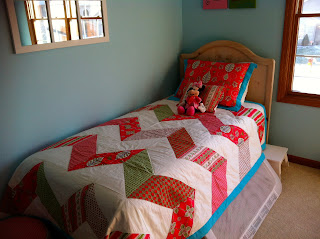But anyway, Mom and I have been working on a quilt for my daughter's room, and this past weekend, we finished it! I love love love how it turned out, and E does too. It is just perfect for her room. Ever since we put together her awesome baby girl nursery, I've been hoarding scraps of the fabric (from Michael Miller's Whimsy collection) to use on her big girl bed. Now the bed matches all the other pieces from her nursery - the window valance, rocking chair pad, doll cradle blanket and pillow and an additional throw pillow.
I only had a half a yard or so of about eight different prints, so we chose a chevron pattern so we could use all the different fabrics. Mom found a great white on white print to use as the base and used this triangle method to create the chevron. I should mention that Mom did 90% of the work here, maybe more. These projects always start with me saying something like, "I'm thinking of doing this... it looks easy enough" and end with Mom staying up until 3 a.m. hand stitching a blanket binding. So kudos to Mom for her sewing skills and willingness to participate in my crazy ideas.
Speaking of the blanket binding, one of the things that stumped us was how to do mitered corners that didn't leave seams somewhere. We watched and read quite a few tutorials online, and quite honestly, they were more confusing than helpful. But after much trial and error, we figured out our own way to do it. And since we both agreed that I'll probably call Mom with a crazy idea for another quilt in a couple years, we had better write this down.
So here goes...
First, determine how wide you want your binding to be (we went with 2 inches) and quadruple it. Cut four strips, equal to the length of each side, plus a half inch or so on each end. Our strips were 8 inches wide. First, fold over the ends about a half inch to hide the raw edge. Fold in half and press in a seam. Then fold the edges into the middle and press again. It should look like this.
The nice thing about our method is that you're not actually mitering corners. Instead, you're sewing down two edges, and then sewing on two more edges that have diagonal ends. So for two of the (opposite) sides, you stitch on the binding like you are putting on bias tape. Just make sure your edges are folding in so you don't have any raw edges.
Now, for the mitered sides. Take another strip and fold it like pictured here.
Place it on your quilt like this.
The right side is the raw edge of the quilt. Machine stitch the entire length of the binding in place from where you see the black pins (the fold on the far right). Then turn the rest of the binding over on itself. You can see here how it creates your first miter. Hand stitch the diagonal in place. Mom says to use an invisible stitch.
Now flip the entire blanket over, and fold the remaining loose binding down on the other side. This will create the miter on the back side. Hand stitch the corner and entire length of the binding. (You could probably use the machine if you don't mind a visible seam on both sides, but again, mom and I are perfectionists.)
Repeat this three more times and you have a perfectly mitered blanket binding. Ta da!








No comments:
Post a Comment